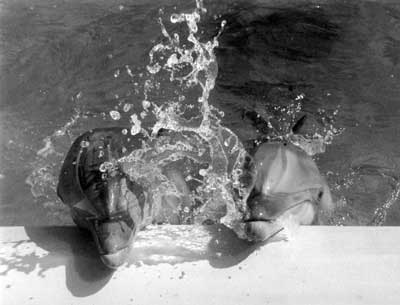
In 1974 I received a fellowship from the National Endowment for the Arts for my year long Dolphin Performance Project at Marineland in Florida. That project involved training two young female dolphins to swim sustained synchronous swimming patterns. The training process involves shaping behavior and in that sense I regard the end result as behavior sculpture. Betty and Eva, a short documentary film on the project includes original music and has has been shown on HBO and Nickelodeon. The project was the among the first controversial NEA grants.
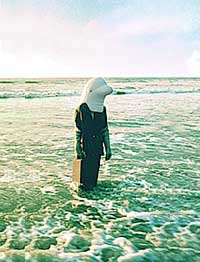
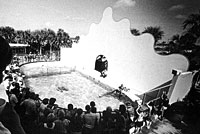
Dolphin Performance Project 1974 – 1976
After grad school I was lost. A teaching job in Kentucky that had been offered not once but twice by separate individuals in the department each time was mysteriously withdrawn. So frustrated by the absence of teaching opportunities I chose to set my sights on a different level. Public art. I felt that it was a shame that art was so distant from society and the public … I looked at the issue and concluded that art was one of a kind hand made objects that were made by artists, bought by collectors, sold by dealers, and reviewed by critics. That was the extent of the public audience. Contrast that with books, recordings, movies, theater, etc. … and you see a huge difference in the size of the audience and the resources available to the creative talent involved. Art was estranged from the public for economic reasons. I prophesied a change in the estrangement. I saw the change coming about through performance art that would be like a bridge between art and the public without the economic obstacle posed by the high price of handmade objects that inform and charm and seduce slowly over time when you literally live with them. You neither fall in love with art nor truly understand it in the general sense by going to museums where it is free. You have to have some of it in your house. The only ones who go to gallery openings are artists, dealers, collectors and critics.
So I gave a lecture on the topic at the University Art Museum at UC Berkeley. The lecture was in the spring of 1974 just months before I was to move to St. Augustine, Florida and begin my dolphin performance project. That year I had received a grant from the national endowment for the arts to do the project. The year before I had been awarded the grant but after I mistakenly spoke to a GAO person the grant was taken away in response to a kangaroo court wherein a few projects like mine that were outside the traditional modes of sculpture, painting etc. were put on trial. The year before that I applied and because a friend who had received funds from HEW coached me in the application process and my proposal was presented like an HEW proposal it was denied on the assumption that it was a joke. A joke that I had spent year writing. A few days before the Berkeley museum lecture a reporter called me up and asked me what I planned to do. At the time the project was called Porpoise Opera Project because that is what Marineland in FL called their bottle-nosed dolphins and opera was something they could relate to also. So she continued asking, “Are you going to dress them up in opera clothes?” I replied, “No. They would not be able to swim for one thing and even if they could you wouldn’t be able to see what they are wearing under the water.” I continued that I was not forming any preconceptions. I thought I had handled that reasonably well. Nope. About a year later my name and the project turned up in a New Yorker list of “golden fleece award” endeavors wherein it said I was going to dress dolphins in opera clothes. St. Augustine, FL is the oldest city in America. At least that is what they say there on their tourist brochures and in the historic area of town. Marineland is about 30 miles south on highway A1A and about 30 miles north of Daytona Beach. It is right next to the beach and has a wonderful history. 20,000 Leagues Under the Sea was filmed there. The Creature From the Black Lagoon was filmed there. I have a great photo of me in a giant larvae costume in front of a big rock with a plaque embedded in it that says Marineland, 1936 (see photo).
When I arrived there in the summer of 1974 it was not new to me. I had been there before to talk about the project with the president of Marineland, cliff Townsend. Marineland paid my way a few years before and I stayed out there in the Marineland hotel and had a free pass for anything I wanted at the very nautical restaurant and bar. I still remember the warm nights when I would walk on the beach and smoke a joint. It was so enchanting and I was so fulfilled … I had realized a dream. I was going to have the opportunity that no one gets let alone dares to dream.
I was going to be able to spend a year with two young female dolphins for the purpose of making art. The joint didn’t do anything. Nothing could eclipse the high I was on from the situation. The moon above the black silky sea. The outline of the tropical jungle across the highway. The flamingos all around. The sound of the surf. The warm humid salty air. The free meals with a view of the surf right outside the window. And the dolphins … the dolphins made everything I just mentioned plain and common by comparison. I felt blessed.
I was living on the beach in town or just outside of town. Literally on the beach. The house was like a cardboard box. No heater. The water smelled like sulfur. And I noticed that the cars had holes in them. When I asked I was told, “Oh yeah, down heaah the cars rust out from the salt air … you might could get yours undercoated to prevent it.” I would occasionally see a car with what looked like a blister under the paint. One time I touched it with my finger and my finger when through the body and left a hole. Oh yeah, the insects. Cockroaches the size of mice were everywhere. Rhinoceros beetles that fly without seeing crash into you. No-see-ems so small you can’t see them infest your arms; at exactly 4:30 pm every day the stinging would commence. And I should not forget to mention another detail. Hurricanes. I experienced 60 mph winds and that was enough to understand I did not want to be around for 100 mph hour winds … I missed my chance to appreciate the tornado that took out the Cadillac dealership one night when I was sleeping. But wait! That’s not all! Along with all that you get LIGHTNING STORMS AND THUNDER that leaves a metallic taste in your mouth because there is no delay between the flash and the CRACK-BOOM!! It is right there where you are and causes the earth to shake … along with you. The metallic taste is ozone. But that is all phenomena … it is neither good nor bad. That is just what nature brings. Something that is more questionable is the neighborhoods tucked away that you don’t see unless you wander into them where houses have dirt floors and huge black women can be seen carrying shopping bags filled with loaves of wonder bread. It would be an oversight if I didn’t mention the spectacular beaches as well. The beaches are great. White soft sand. Puffy golden dunes. Gentle surf compared to the rough and tumble Pacific. But everything has its flip side and the Florida beaches are no exception. You might be lying on the sand up and away from the water … napping … and then awaken to a familiar but surprising sight and sound … a huge four wheel drive truck coming towards you! Yes. You can drive on the beach if you want. It is especially a problem at night when you want to lie in the sand and listen to the surf and stare at the stars … teenagers storm the beach in their cars and trucks to park at the water’s edge and make out. If you are in the wrong place at the wrong time you will be run over. What else could there be? FUCKING GIANT SHARKS! Right where the waves break. There are shark clubs that would come out to the beach right behind my house. They would cut a huge fish in half and put a monster hook through it attached to fishing line the thickness of a Ticonderoga #2 pencil and paddle out with the bait in a boat and drop the bait where the surf breaks. I saw them haul in 9-ft. long hammer-head sharks.
Oh, that did not deter me from going in the ocean … no way … I went in all the way up to my ankles. This was my third visit to St. Augustine. The second is worth mentioning as well because it will give you the social flavor of my experience there. After the governor took my grant away in 1973 I wrote a commercial script for Marineland to use in their new stadium they had planned. Cliff Townsend liked it and flew me out again expenses paid. This time I worked with a show director they had hired. More about that later. My first day on the project I met with Fred Lyons who had been a trainer at Marineland for 18 years. He was the best. And he proved that to me beyond my expectations. He took me back to what was formerly the sea lion tank where there now resided two young female dolphins for me to work with. We walked through a dark cinderblock “prop room” and exited it onto the sun-drenched cement deck attached to the pool of water which was 60 ft. long and 30 ft. wide and 7 ft. deep. As we walked out onto the deck the dolphins raced around the tank. Fast doesn’t describe it. They were like acrobatic torpedoes. There frequent arcs out of the water were punctuated by loud blasts of air which was the sound of them exhaling through their blowholes. Like the pneumatic air guns used to take tires off and on there was a lot of force. Fred kneeled down at the edge of the deck. I came over and joined him. He slapped the side wall. One of them came right up and onto the deck. Half of her body was out of the water. She wiggled a little seeing Fred had no food and just as quickly slipped back into the water. But she stayed there. Fred said, “This is Betty. I named her after my wife. She is very smart.” I leaned down and said, “Hi Betty!” Betty responded with a movement of her head that was so quick it seemed like a big twitch. The next thing I knew I was soaked. And she was looking at me with a grin that I would come to know all too well. It was the beginning of a long training process I will never forget. The thing is I had no idea that I was the one that would be trained so skillfully that I had to be told it was happening by observers. Betty is still at Marineland. Smart is not a sufficient term to describe her. Fred said, “The other one has no name. You can name her.” Then he went into the prop room and got a bucket of fish out of the refrigerator in there and showed me how to feed them. I named Betty’s partner Eva. And so began my experience with Betty and Eva. An experience that I am about share that I feel very frightened about as I sit here and peck at my keyboard waiting for my Parkinson’s disease medication to kick in. Using my left hand as my right hand shakes wildly I am fearful of the intense emotion that I have repressed may be released by my telling this story.
My next meeting was with Cecil Walker the general manager. Cecil had started in the pump room of the circular tank thirty years ago. He knew everything there was to know about the plant. As I walked into his office and sat down I could feel Cecil’s icy feelings towards me. But his manner was cordial and friendly. We didn’t have much to say to each other and I left politely just as I had come in. I didn’t give it much thought and was totally unaware that this man would be my worst nightmare. Not long before … maybe several years I was told by Fred … Cecil’s son died in a car accident and it changed him into a very mean person. Contrast that with Cliff Townsend, the president. He was a wonderful man. Amazingly and tragically, his whole family was killed in a car accident the year before I arrived. The stadium was where Fred worked as head trainer. The other trainers were Gary, Frank and a young kid Jim Black. They would hang out in a small room in the back between shows. I would come back there and hang with them occasionally after they accepted me even though to them I was a California hippy. When I wasn’ t hanging with them I used to enjoy playing with Moby the young pilot whale not far from the trainer room. Moby was great fun. It took me a while to get up the nerve but eventually I was brave enough to put my arm down Moby’s throat like the trainers would do in the shows as part of a so-called medical exam. Kipper was Moby’s buddy and they shared the same holding tank. Kipper was a very smart dolphin. And also a very horny dolphin. He would get a hard-on and try to hump Moby. The trainers would tell Kipper that if he kept it up eventually Moby who was about 20 times as big as Kipper … would kick his ass big time. The tasks required of me to take care of betty and Eva were formidable. When I arrived as required at 8am the next and every morning … seven days a week every week … I was introduced to the fish house across the highway. It was a cement house with walk in freezers and several large sinks. The various types of fish were in cardboard boxes in the freezer that had to be brought out and opened up. The blocks of frozen fish went into the sinks with water running to defrost the blocks … I had to select the healthy fish from the occasional bad ones and put them in two buckets. One for Betty and one for Eva. Eighteen pounds each. Then I had to carry them to my tank. For the first few weeks my hands would ache from the ice cold water. And my arms would ache from carrying the thirty six pounds of fish.
Fred met me at the tank and gave me a whistle. I blew the whistle and nothing happened but the sound of my breath going through it. Fred showed me how to make a short sharp blast of air using my tongue as a valve over the whistle opening and making a sort of Taaaah … I soon got it. The whistle was a bridge signal that meant “correct”. And, “correct” was always immediately followed by a reward. A fish. In training the key ability to develop was breaking down behavior into discrete segments that could be most easily understood and performed by the dolphins and then formed into a chain of actions which when complete was called behavior. Throwing a ball, jumping over something, vocalization, whatever they could do that was fun or entertaining. What I taught them to do was very different then Marineland was used to seeing. One of the behaviors took nine months of training to learn. Most of what Marineland presented are tricks that took a few weeks at most to learn.
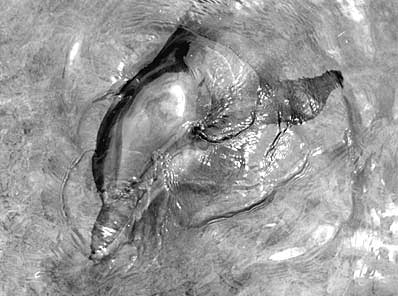
Betty Winks

Betty Gives Me A Ride
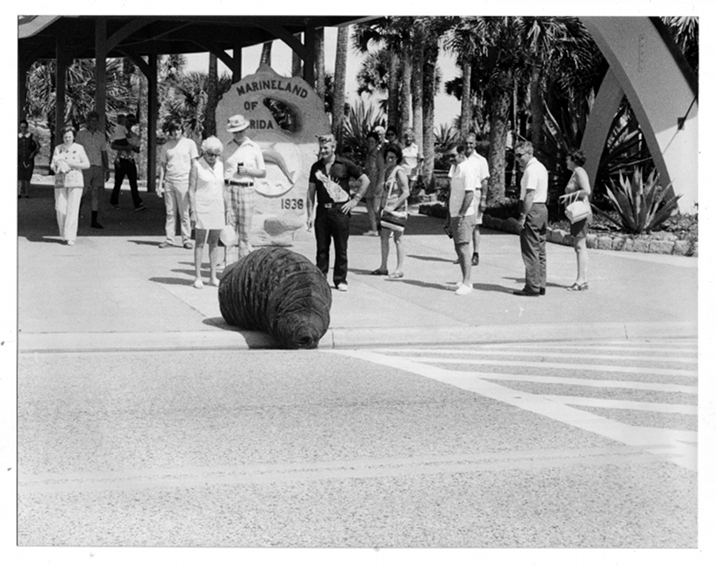
Marc As Giant Larva
B & E Epilogue
When my project was over fred told me that the next day Eva would be moved to the circular community tank. I was wrapped up in the editing of the film in jacksonville. I thought she would be taken care of not being fully aware of the treacherous social dynamics she was entering into. Besides this was Cecil’s decision and I was in no position to do anything about it at that point. Betty was about to face her own nightmare. Cecil had also ordered 232 to be moved into her tank. He was a big male starved for social interaction by isolation as part research by a local university. I used to go over to his tank occasionally and try to play with him. There was a ball in his tank which he would knock out of the tank when I approached. . . down the incline. He deliberately did two or three times and I stopped retrieving the ball. So I would try to pet him and he would hammer my hand with his snout. I say “hammer” because that was what it felt like. The force of the blows was shocking in their power.
But apparently betty handled him. She is so smart it should not surprise me but 232 was so… I was surprised. Eva on the other hand was not as smart as betty. Certainly not when I comes to the dominant male who was known to be brutal to those who resist his desires. I don’t know this but I assume it was his amores desires that she resisted at her own peril. when I went to visit not long after the end of my project she was swimming upside down on the surface of the water. Perhaps better to see him coming as he rammed her with his snout. All the divers were sympathetic but there was nothing they could do under the circumstances. Eva died shortly after. I think about it everyday.